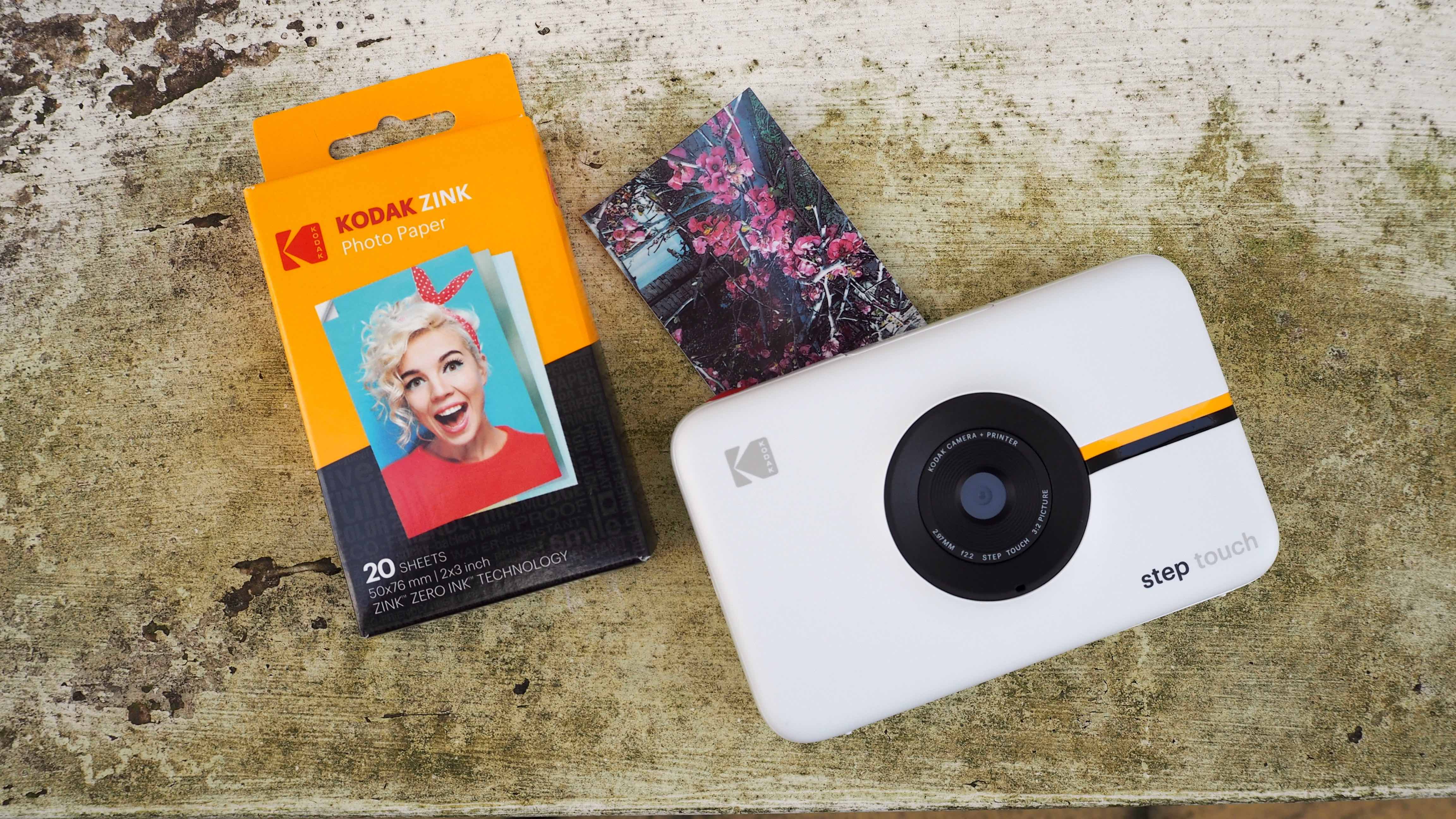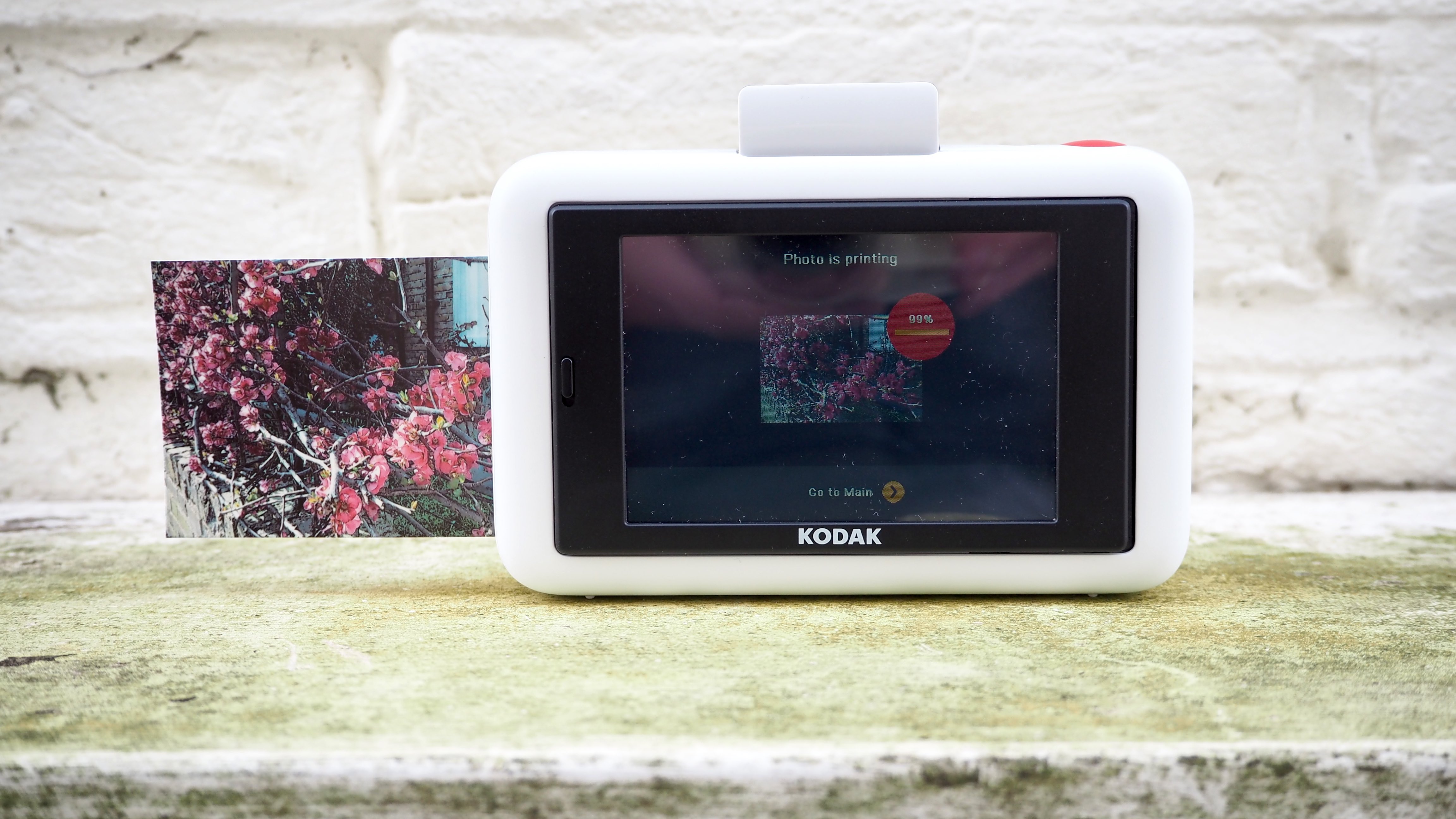Digital Camera World Verdict
The clean looks and retro styling of the Kodak Step Touch Instant Print Digital Camera has cross-generational appeal. Though the build is plastic-y to the touch its construction is relatively solid. Being able to review shots before printing and thereby avoid wasting sheets of ‘Zink’ photo paper is a real plus, as is the ability to use the device as a printer for smartphone snaps. We are paying a slight premium for the inclusion of a 3.5-inch touchscreen over its screen-free Kodak ‘Step’ sibling. But we feel the screen does make the Step Touch much more versatile and future proof.
Pros
- +
Cute and compact camera and printer combination
- +
Zero ink ‘zink’ prints are immediately dry to the touch
- +
Captured images can be reviewed before printing
- +
Adhesive-backed prints can double up as stickers
Cons
- -
Disappointing print quality with washed-out color
- -
Plastic-y feel to the construction
- -
Only 40 prints from a single charge
- -
Premium price for an LCD screen
Why you can trust Digital Camera World
The near-immediate gratification provided by instant print cameras means they’re great fun, as well as an ideal way to introduce photography to the younger generation. They’ll further raise a nostalgic smile from older family members who recall Polaroid cameras from their own childhoods. But while the Polaroid brand which was once a byword for instant prints has made a comeback in recent years, several other players have now muscled in on the scene, including Canon, Lomography, and Fujifilm.
Like Fujifilm, Kodak was once world-renowned for its expertise in film. So it makes sense that the re-emergence of Kodak sees the brand name adorning an instant print camera. However, in something of a twist, there is no film actually involved when it comes to the Kodak Step Touch Instant Print Digital Camera. Though most instant cameras are all-analog devices, this one is essentially a point-and-shoot digital camera and printer in one.
We get a rear screen for composition and review, just like on a regular digital compact, plus the ability to output 2x3-inch credit card-sized prints. Like other cameras from this manufacturer, dry-to-the-touch Zink (zero ink technology) is employed here, with prints emerging fully finished.
So, unlike with competing Fuji and Lomography instant print cameras – both utilizing instant film packs – there is not the same process of waiting for the shot to develop before our eyes. However, it can still be argued that seeing any hard copy print emerge from the same device we’ve just taken a picture on still provides an element of theatre.
And giving the user a photographic 'experience' is ultimately what the Kodak Step Touch Instant Print Digital Camera is all about, as we shall see…
Specifications
Sensor: 16 megapixels
Sensitivity range: Automatic
Video: 1080P/720P
Lens: 2.97mm, f2.2
Monitor: Yes, 3.5-inch LCD touchscreen
Viewfinder: No
Battery life: 40 prints per charge
Dimensions: 6.81x6.34x2.01 inches
Weight: 453.6g
Key features
As expected, the Kodak Step Touch Instant Print Digital Camera is a fixed focus, fixed f/22 aperture camera, meaning that all we have to do is point it at our subject and squeeze the prominent red shutter release button. Friendly on-screen prompts guide us through the operational process from the get-go.
The best camera deals, reviews, product advice, and unmissable photography news, direct to your inbox!
A neat feature here is the pop-up flash that also includes a barely noticeable 'selfie' mirror alongside it. With a tap of the flash icon via the camera's LCD, we can either set the flash to auto, to always fire or leave it switched off. The clever bit is that while this device is no thicker than the average box of matches it still finds room to hide both a built-in printer and a stack of 10 sheets of Kodak-branded Zink photo paper beneath its backplate LCD screen. The screen flips open to allow us to load the paper. If we’ve one grumble here it’s that the bundled starter pack provides just five sheets of paper.
Another difference when comparing this with Instax instant print cameras from rival Fuji is that the Kodak prints are automatically adhesive-backed so that you can enjoy using them as stickers. The rechargeable battery life is good for 40 prints per charge. Though that sounds unspectacular, how often will we actually attempt to sequentially print 40 images? Almost never.
Unusually for an instant print camera, another advantage of the Kodak Step Touch’s digital engine is that it’s capable of not just capturing still photos up to 13 megapixels in size, but also shooting Full HD 1920x1080 resolution video sequences. There’s the option to insert a microSD card of up to 256GB capacity into the base of the unit in order to save both for posterity.
While there is no optical viewfinder here, the large 3.5-inch LCD touchscreen provides intuitive operation, even if it does essentially turn into a mirror in direct sunlight, rendering the ability to see whatever the lens is seeing, rather than what’s reflecting onto the screen, somewhat difficult.
If you are tempted to buy this instant print camera be aware its manufacturer also offers an outwardly similar but less expensive Kodak Step instant print digital camera – without the touch element. The Step comes without an LCD screen and features a pop-up optical viewfinder whereas the Touch instead features a screen and its pop-up flash.
Build & handling
Like instant print photography itself, the Kodak Step Touch Instant Print Digital Camera suggests cross-generational appeal courtesy of a minimalist yet sporty design, complete with a retro 'go faster' stripe in on-brand Kodak yellow and black. Another old school feature is that raised flash directly above the lens, a placement that means there’s a greater likelihood of avoiding instances of 'red eye' than if the flash was actually incorporated into the body. Since the camera’s f/22 aperture is hardly the brightest, the flash is handy for those inevitable party pictures.
Held in the palm, the device is shorter than the average mobile phone handset, while at the same time being two or three times the depth, to allow for the printer element. That said it’s a lot less bulky overall than even competing Fujifilm Instax 'mini' instant print cameras. By contrast, as its blurb suggests, the Kodak Step Touch Instant Print Digital Camera will indeed fit neatly into a pocket or purse. Plastic-y in construction, in the hand the device feels somewhere between a toy and a 'proper' camera, which, given the breadth and age range of its possible audience, is perfectly pitched.
A press of the small latch secreted within the bezel of the back screen opens the back of the camera, providing a recess into which we load our smudge-proof and water-resistant Kodak Zink photo paper, 10 sheets at a time. Before any printing can begin, the blue color calibration sheet included with each fresh pack is ejected. And then we’re ready to go.
Helpfully provided out of the box is a wrist strap, a USB cable for recharging the non-removable internal lithium battery, a small printed beginner’s guide, plus a packet of five sheets to get us started. There's no USB mains plug provided in case we’re thinking of charging it that way rather than via an available port on the PC, but any USB-enabled smartphone plug will do.
Performance
Like all instant print cameras, as far as operation goes the Kodak Step Touch Instant Print Digital Camera is point-and-shoot all the way. If we have got a grumble it’s that the rear LCD screen utilized for shot composition and review is highly reflective, meaning it’s trickier than usual to view outdoors in sunlight.
Squeeze the shutter release button – red on our all-white review sample, although an all-black alternative is additionally available – and, after the camera has considered its options for a little while, we hear the familiar whirring and grinding of internal gears before our sheet of the pre-loaded paper begins to slowly and emerge from a narrow slit in the left-hand side of the device, if viewed lens-on.
While we love the above bit of theatre, unfortunately, the print output doesn’t force us to revise our long-held impressions of ‘Zink’ prints. Disappointingly they still closely resemble glossy color photocopies rather than proper photo lab-developed prints. That’s fine for when we want to peel off the back of our prints and stick them on the fridge or in a scrapbook, but these aren’t images we’d want to display on a mantelpiece or in the family album for future generations, nor do they have the charm of an original Polaroid or even current generation Fuji Instax print.
Still, in an age when most of our photographs are only stored in the Cloud or on our smartphones, credit card-sized stickers – ultimately disposable as they are –suggest marginally more permanence.
Verdict
While dry-to-the-touch zero ink, or Zink technology has its advantages when it comes to the fast and easy production, sharing, and application of prints and stickers, to our eyes the results straight out of the camera are still no match for the original film era Polaroid cameras, or indeed the modern era Fuji Instax cameras that successfully ape them.
That said, the Kodak Step Touch Instant Print Digital Camera is much more compact and portable than either a modern Fuji or old-school Polaroid, so perhaps it’s the camera we’re more likely to take out and about and have with us when inspiration for a selfie or a pictorial memento strikes. If we further view Kodak’s LCD incorporating camera and printer combo as the bit of fun it’s intended to be, then any criticism of plastic-y build and washed-out looking prints feels somewhat churlish – as long as we can nab one for a value-added price.
You may also like...
As mentioned in our introduction, alternative instant print cameras are offered in the form of Fujifilm's Instax range such as the Instax Mini 12, or Instax Wide 300, or from Polaroid with the Polaroid Now. Canon also provides a connected printer for printing photos quickly from phones with its Zoe Mini range.
Simplistic though it may at first seem, the Kodak Step Touch Instant Print Digital Camera has a lot going for it though, including the backplate touch screen with helpful operational prompts, Bluetooth connectivity, and the ability to save photos and videos to an optional microSD card, just like a regular digital camera – albeit one that output prints for us too.
Gavin has over 30 years’ experience of writing about photography and television. He is currently the editor of British Photographic Industry News, and previously served as editor of Which Digital Camera and deputy editor of Total Digital Photography.
He has also written for a wide range of publications including T3, BBC Focus, Empire, NME, Radio Times, MacWorld, Computer Active, What Digital Camera and the Rough Guide books.
With his wealth of knowledge, Gavin is well placed to recognize great camera deals and recommend the best products in Digital Camera World’s buying guides. He also writes on a number of specialist subjects including binoculars and monoculars, spotting scopes, microscopes, trail cameras, action cameras, body cameras, filters and cameras straps.







